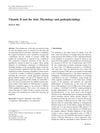TLDR Vitamin D3 and its receptor help protect skin from UVB-related cancer.
The study explored the protective role of 1α,25(OH)2-dihydroxyvitamin D3 (1,25(OH)2D3) and its receptor VDR against UVB-induced skin tumor formation, focusing on their interaction with the β-catenin pathway. It was found that VDR knockout mice were more susceptible to skin tumors, and this was associated with increased β-catenin signaling. The research demonstrated that 1,25(OH)2D3 suppresses key proteins involved in epidermal carcinogenesis, such as cyclin D1 and Gli1, which are regulated by β-catenin/TCF signaling. Blocking VDR led to hyperproliferation of keratinocytes and increased expression of these proteins. The study concluded that VDR might protect against UVB-induced skin cancer by interacting with the Wnt/β-catenin pathway, although further research was needed to fully understand the mechanisms involved.
100 citations
,
August 2011 in “Journal of Investigative Dermatology” Lack of vitamin D receptor increases skin tumor risk by boosting hedgehog signaling.
 556 citations
,
September 2008 in “Genes & Development”
556 citations
,
September 2008 in “Genes & Development” Wnt signaling is vital for cell growth, development, and cancer research.
148 citations
,
May 2008 in “The journal of investigative dermatology/Journal of investigative dermatology” Mice without the vitamin D receptor are more prone to UV-induced skin tumors.
127 citations
,
January 2008 in “PloS one” Vitamin D receptor helps control hair growth and could be used to treat certain skin tumors.
 829 citations
,
May 2007 in “Nature”
829 citations
,
May 2007 in “Nature” Hair follicles can regrow in wounded adult mouse skin using a process like embryo development.
378 citations
,
February 2020 in “Nature Reviews Endocrinology”  158 citations
,
August 2011 in “Reviews in endocrine and metabolic disorders”
158 citations
,
August 2011 in “Reviews in endocrine and metabolic disorders” Vitamin D and its receptor regulate skin functions like cell growth, immunity, hair cycle, and tumor prevention.
71 citations
,
October 2014 in “The Journal of Steroid Biochemistry and Molecular Biology” Vitamin D receptor helps prevent skin cancer and supports skin health.
13 citations
,
July 2020 in “World journal of stem cells” Vitamin D and calcium are important for skin stem cell function and wound healing.
9 citations
,
June 2023 in “Cells” Certain natural and synthetic compounds may help treat inflammatory skin diseases by targeting a specific signaling pathway.



